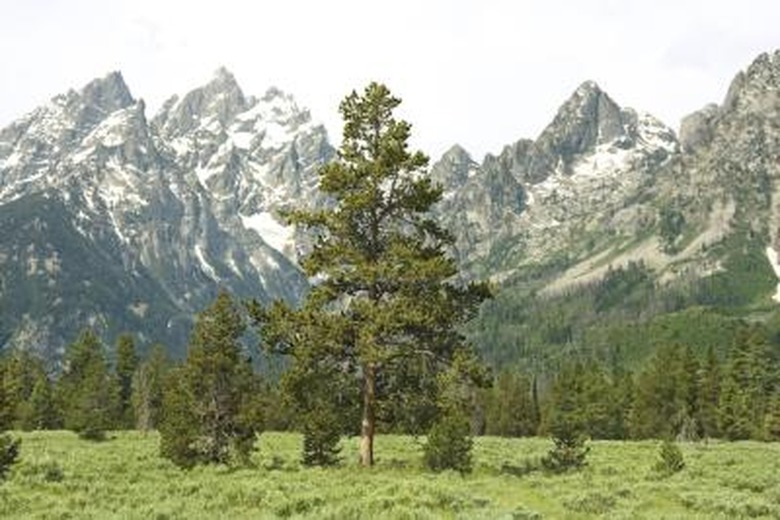How Does Altitude Affect Vegetation?
Plant life grows at impressive elevations – there are mosses happily photosynthesizing above 21,000 feet on the shoulders of Mount Everest, the world's tallest mountain. But higher altitudes challenge vegetation with rigorous conditions, resulting in special adaptations and visible effects on growth form. From howling winds and long-lasting snows to cold temperatures and intense solar radiation, high-elevation plants must be hardy in the face of their physical environment's demanding elements.
High Elevation and Plants: Temperature and Growing Season
High Elevation and Plants: Temperature and Growing Season
High-country temperatures can be severely cold indeed, particularly during winter in middle and high latitudes. In the lower atmosphere, temperature declines with altitude at the so-called "lapse rate," shaking out roughly to a decrease of 3.5 degrees Fahrenheit for every 1,000 feet of elevation gain.
This means that under normal conditions, plants growing on elevated terrain deal with colder conditions – colder air, colder soil – across the year than lowland counterparts. Yet severe cold in and of itself isn't necessarily a dealbreaker when it comes to vegetation – hardy plants such as subalpine conifers can survive crippling temperatures well below zero.
The more important factor limiting plants at higher elevations is the length of the growing season. While they can endure very low temperatures, for example, those mountain conifers still need a couple of months of only minimal frosts to put on new growth. Those fresh shoots, more cold-vulnerable, need time to "harden off" before the mercury plunges again.
This hardening-off process depends on adequate photosynthesis, the process by which plants use solar energy to convert carbon dioxide (CO2) and water into usable energy in the form of glucose. Plants can't photosynthesize below a certain temperature threshold, but this varies across species. Many high-elevation plants are able to conduct photosynthesis at colder temperatures than low-elevation plants.
Precipitation, Plants and Altitude
Precipitation, Plants and Altitude
As a general rule, higher-elevation land receives more precipitation than lowlands. In broad highlands, this may simply be because the generally cooler air has less capacity to hold moisture, generating clouds and precipitation more readily. But hills and mountains also actively induce precipitation through what's called the orographic effect: Air shoved upwards by terrain cools to condensation point, resulting in cloud formation and precipitation.
This means that higher country in prevailingly arid regions can often support lusher, denser and taller vegetation than the dry valleys and basins at their feet. Desert mountain ranges may rise high enough to allow for forest growth, forming isolated "sky-island" habitats.
In tropical and subtropical regions, heavy precipitation combined with chronic mists from orographic effects helps nurture cloud forests, often more stunted than lower-elevation forests but luxuriantly cloaked in mosses, lichens, ferns and other epiphytes.
Light Intensity in the Heights
Light Intensity in the Heights
Lower air density and particulate matter at higher altitudes translates to greater solar radiation. Ultraviolet (UV) irradiance at high levels – and particularly UV-B – can cause tissue damage and other issues in plants. Greater UV-B irradiance with altitude is countered by less atmospheric scattering and the generally increased cloudiness higher up. Some of the most intense UV-B exposure that timberline and alpine plants experience may come in spring with the combination of more direct sunrays and plentiful snow reflecting sunlight and thus enhancing irradiance.
Studies suggest high-elevation plants have evolved some resistance to their environment's greater UV-B radiation through adaptations such as thicker, smaller leaves and an increased concentration of ultraviolet-absorbing pigments such as flavonoids in their tissues.
Less Carbon Dioxide
Less Carbon Dioxide
There's inherently less carbon dioxide available to alpine plants due to the lower air density and atmospheric pressure at altitude. Yet evidence suggests that reduced carbon dioxide isn't an important limiting factor for plants at high elevations. One reason may be that diffusion rates of gases increase with lower atmospheric pressure, allowing for easier uptake by plants and perhaps compensating for carbon dioxide's lower partial pressure and availability.
The Influence of Snowpack
The Influence of Snowpack
In mountainous mid- and high-latitude regions, snow often persists much longer in the cooler, moister high country than down in the lowlands. Snowpack is both a blessing and a curse for plants. It insulates groundcover, low shrubs and saplings, and the lower branches of trees from winter's severe temperatures and drying winds. In temperate maritime climates especially, snow may completely swaddle high-elevation trees, similarly buffering them from the worst of frigid cold.
Long-lasting high-elevation snow that melts off slowly also supplies critical moisture for mountain plants during the summer, supporting lusher vegetation where less-snowy sites result in drier conditions.
But lingering snowdrifts and snowfields that persist well into late spring or early summer – or longer – can also limit the growing season at a particular site, preventing most plants from gaining a foothold.
High-Country Howlers: The Influence of Wind
High-Country Howlers: The Influence of Wind
Many high-elevation areas, particularly mountains, experience significantly higher windspeeds than lower elevations. Higher-altitude winds not slowed by the frictional drag of the lower ground surface can hit high hills and mountains rising into their airstream. At upper elevations, furthermore, low-growing vegetation such as stunted tree scrub and tundra doesn't disrupt blowing wind to the same degree as taller vegetation lower down.
This means high-country plants often deal with major wind-pummeling. Wind sculpts plant growth by mechanically breaking stems and branches, abrading plants with windborne grit and increasing evaporation, thus heightening moisture stress (especially in winter on higher-latitude mountains, when frozen soil limits trees' ability to replace water via roots). Trees on windswept slopes may show a "flagging" effect, with sparse, stubby growth on the windward side and longer, denser leeward boughs.
Cite This Article
MLA
Shaw, Ethan. "How Does Altitude Affect Vegetation?" sciencing.com, https://www.sciencing.com/how-does-altitude-affect-vegetation-12003620/. 30 September 2021.
APA
Shaw, Ethan. (2021, September 30). How Does Altitude Affect Vegetation?. sciencing.com. Retrieved from https://www.sciencing.com/how-does-altitude-affect-vegetation-12003620/
Chicago
Shaw, Ethan. How Does Altitude Affect Vegetation? last modified August 30, 2022. https://www.sciencing.com/how-does-altitude-affect-vegetation-12003620/
